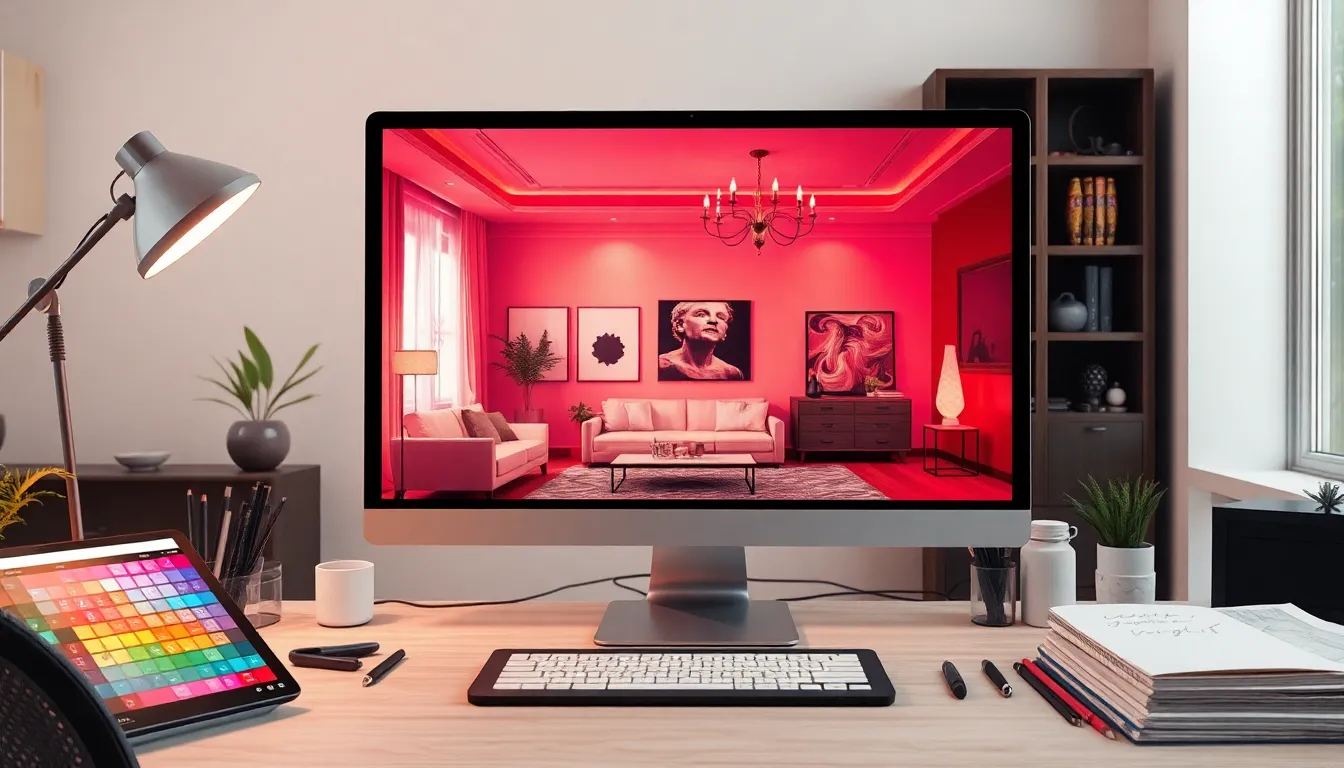Table of Contents
ToggleIn a world where first impressions matter more than ever, interiörsrendering is the secret weapon every designer needs. Imagine walking into a space that looks so good it could be the cover of a magazine—without lifting a paintbrush or moving a single piece of furniture. That’s the magic of interior rendering. It’s like having a crystal ball for your home, giving you a sneak peek into your dream space before you commit.
Overview of Interiörsrendering
Interiörsrendering serves as a pivotal tool for designers, enabling them to craft detailed visual representations of interiors. This technology empowers individuals to visualize their spaces in a realistic manner, enhancing decision-making processes.
Definition and Importance
Interiörsrendering refers to the process of creating realistic 3D images of interior spaces. It plays a crucial role in interior design, as it allows designers and clients to visualize concepts before implementation. By presenting accurate representations, interiörsrendering aids in communicating design intentions clearly. This technique helps in minimizing misunderstandings, leading to more successful projects. Examples of its significance include saving in construction costs, time investment, and improving client satisfaction levels.
Historical Background
The roots of interiörsrendering trace back to the early days of architecture. Initially, manual sketches and paintings represented interior spaces. Advancements in technology, especially in the late 20th century, introduced computer-generated imagery. This shift transformed how designers presented their ideas, leading to the development of sophisticated software applications. By the early 2000s, realistic rendering became widely accessible, increasing its adoption among designers. Now, it stands as a standard practice in the industry, reshaping how interior design concepts are visualized and executed.
Types of Interiörsrendering

Interior rendering encompasses various techniques that serve specific design needs. Two primary types stand out: 2D rendering and 3D rendering.
2D Rendering
2D rendering provides flat visual representations of interior spaces. Designers often use this method to create floor plans and layouts. This approach emphasizes dimensions and spatial relationships, allowing clients to understand room configurations. It serves as a useful tool for quick visualizations without intricate details. 2D images typically feature simplified color schemes and textures, promoting clarity over realism. Many designers utilize software like AutoCAD and SketchUp to generate these visuals, granting flexibility in early design stages.
3D Rendering
3D rendering involves creating detailed, three-dimensional representations of interior spaces. This type of rendering captures textures, lighting, and realistic materials, producing lifelike images. Clients gain a comprehensive view of proposed designs, enabling better decision-making. This method often utilizes advanced software such as Blender or 3ds Max, enhancing visual appeal. Real-time rendering technology further improves immersion, allowing for interactive design experiences. As a result, 3D rendering has become indispensable in modern interior design, meeting clients’ needs for accuracy and detail.
Tools and Software for Interiörsrendering
Numerous tools and software exist for effective interior rendering, catering to various design needs and preferences.
Popular Software Options
Software like AutoCAD and SketchUp leads the market for 2D rendering, offering essential functionalities for creating floor plans. Blender and 3ds Max dominate the 3D rendering space, providing advanced features for creating realistic visuals. Lumion and V-Ray enhance these platforms with powerful rendering capabilities and efficient workflows. Architects and designers often use Revit for BIM integration, allowing streamlined design processes. On the other hand, SketchUp Pro offers an intuitive interface and robust plugin support, making it suitable for both beginners and professionals.
Comparison of Features
Comparing software options reveals distinct strengths. AutoCAD excels in precision for 2D layouts while SketchUp is user-friendly and flexible for 3D conceptualization. Blender provides comprehensive tools for modeling and texturing, making it popular among visual artists. V-Ray integrates seamlessly with various platforms, ensuring high-quality render output. Lumion stands out for its speed and real-time rendering, favoring those needing swift results. Revit focuses on architectural design, enhancing collaboration through BIM, which benefits larger projects. Each program caters to specific user requirements, making the selection crucial to project success.
Applications of Interiörsrendering
Interior rendering finds extensive use in various applications across the design spectrum. Its versatility enhances both residential and commercial environments.
Residential Projects
Interior rendering plays a critical role in residential projects, allowing homeowners to visualize their space vividly. Designers use it to present proposed layouts and decor choices to clients. This technique simplifies decision-making, helping clients select colors, materials, and furnishings. A realistic 3D representation brings ideas to life, giving a true sense of scale and ambiance. Homeowners benefit from seeing different styles and configurations, ensuring their vision aligns with the final outcome. Effective visualizations can even influence purchasing decisions by showcasing potential selections in a relatable context.
Commercial Spaces
Commercial spaces also benefit significantly from interior rendering, as businesses aim for eye-catching designs that attract customers. Retail environments utilize detailed visual representations to convey branding and atmosphere. Designers leverage 3D rendering to evaluate space optimization for functionality and flow. Potential clients gain insight into how layouts foster customer interaction and improve operational efficiency. Presenting these images facilitates discussions among stakeholders, paving the way for informed choices. Flawless visualizations create confidence in the design process, ultimately leading to well-executed commercial environments that align with business goals.
Interior rendering stands as a transformative force in the world of design. It bridges the gap between imagination and reality, allowing clients to visualize their spaces in intricate detail. By leveraging advanced software and techniques, designers can present ideas that resonate with their clients’ visions, fostering collaboration and understanding.
As this practice continues to evolve, its role in both residential and commercial projects becomes increasingly vital. With the ability to create realistic environments, interior rendering not only enhances decision-making but also elevates overall satisfaction. Embracing these tools and techniques ensures that designers can deliver exceptional results that truly reflect their clients’ aspirations.










